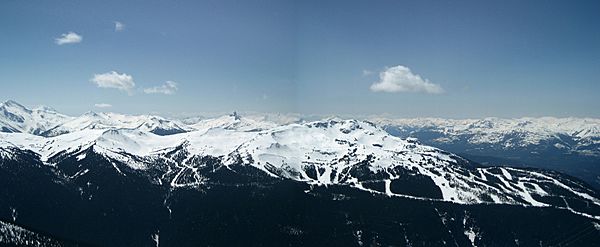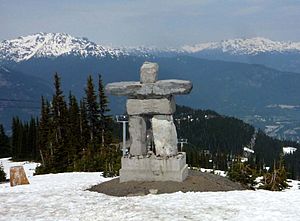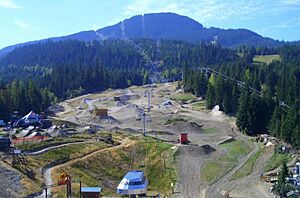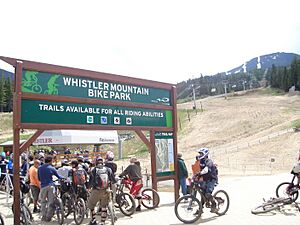Whistler Blackcomb facts for kids
Quick facts for kids Whistler Blackcomb |
|
|---|---|

Panorama of Whistler Blackcomb
|
|
| Location | Whistler Mountain and Blackcomb Mountain |
| Nearest city | Vancouver |
| Coordinates | 50°06′30″N 122°56′33″W / 50.10833°N 122.94250°W |
| Vertical | Whistler: 1,530 m (5,020 ft) Blackcomb: 1,565 m (5,133 ft) |
| Top elevation | Whistler: 2,182 m (7,160 ft) Blackcomb: 2,436 m (7,992 ft) |
| Base elevation | Creekside: 653 m (2,140 ft) Village: 675 m (2,214 ft) |
| Skiable area | Whistler: 4,757 acres (1,925 ha) Blackcomb: 3,414 acres (1,382 ha) |
| Runs | 200 |
| Longest run | Peak To Creek(Whistler), Green Road (Blackcomb): Both are 11 km (6.8 mi) |
| Lift system | 37 (Whistler 19)(Blackcomb 17) 5 gondolas 2 high-speed six-pack chairlift 12high-speed quad chairlifts 3 fixed grip chairlifts 15 surface lifts |
| Lift capacity | 100,000 skiers/hr Whistler: 34,345 Blackcomb: 31,162 |
| Snowfall | 11.9m/year (467 in.) |
| Snowmaking | Whistler: 215 acres (87 hectares), 4.5% Blackcomb: 350 acres (142 hectares), 10.3% |
| Website | Whistler Blackcomb |
Whistler Blackcomb is a huge ski resort located in Whistler, British Columbia, Canada. Many people consider it the largest ski resort in North America. It also has the most powerful lift system, which means it can carry more skiers up the mountain per hour than any other resort.
This amazing resort features the Peak 2 Peak Gondola. This special gondola connects Whistler and Blackcomb mountains high up in the sky. Because it's so big and has so many lifts, Whistler Blackcomb is often the busiest ski resort. It welcomes over 2 million visitors every year!
Whistler was first planned as part of a try to host the 1968 Winter Olympics. Even though that bid didn't win, construction started anyway. The resort first opened in January 1966. Blackcomb Mountain, which was a separate resort, opened later in December 1980.
The two resorts were big rivals in the 1980s and 90s. They constantly added new and better features. This made them stand out from other resorts. By the mid-1990s, ski magazines often called the area the best resort around. Later, a real estate company called Intrawest bought Whistler in 1997. They fully combined the two resorts in 2003.
Whistler Blackcomb became a key part of Vancouver's new try for the 2010 Winter Olympics. Vancouver won the bid in July 2003. Whistler Blackcomb then hosted the alpine skiing events. This included downhill, Super-G, slalom, giant slalom, and super combined races for both Olympic and Paralympic athletes. Unlike another Olympic venue, Whistler Blackcomb had a lot of natural snow during the 2010 Olympics. It even had its second-highest snowfall ever that season!
In 2016, an American company called Vail Resorts bought Whistler Blackcomb for a lot of money.
Contents
- Exploring Whistler Blackcomb's Mountains
- The History of Whistler Blackcomb
- Early Visitors and the First Resorts
- Olympic Dreams and Whistler's Opening
- The Creation of Whistler Village
- Blackcomb Mountain Opens
- Growing Through Competition
- Intrawest Buys Blackcomb
- More Competition and Awards
- Intrawest Buys Whistler and Combines Operations
- The 2010 Olympic Games
- Whistler Blackcomb in the 2010s
- Major Events Hosted at Whistler Blackcomb
- Major Lifts for Winter Fun
- Major Lifts for Summer Fun
- Fun Activities Beyond Skiing
- Images for kids
Exploring Whistler Blackcomb's Mountains
Whistler and Blackcomb ski areas are on two long ridges. These ridges run from northwest to southeast. A deep valley with Fitzsimmon's Creek separates them. The main village, Whistler Village, is at the northwest end of this valley. Most ski runs go down towards the village. Some runs on Whistler Mountain go to the Creekside Base area.
Whistler Mountain: The Southern Ridge
Whistler Mountain is the southern ridge. It's on your right when you look at the resort from Whistler Village. Its top is at 2,182 meters (7,160 feet). The mountain has a total vertical drop of 1,530 meters (5,020 feet). It offers 4,757 acres of skiable land.
Whistler Mountain has 19 lifts. These include 2 gondolas, 5 high-speed quad chairlifts, and 2 high-speed six-pack chairlifts. It also has 2 fixed-grip triple chairlifts, 1 T-bar, and 7 carpet lifts. The Peak 2 Peak Gondola also connects Whistler to Blackcomb Mountain here. There are 4 restaurants on the mountain and a ski school for kids. You can start skiing from two base areas: Whistler Creek (also called Creekside) and Whistler Village.
Blackcomb Mountain: The Northern Ridge
Blackcomb Mountain is the northern ridge. It's on your left when you look from the village. Its highest lift-served point is 2,240 meters (7,349 feet). The very top of Blackcomb Mountain is even higher, at 2,440 meters (7,992 feet), but you can't reach it by lift.
Blackcomb has a greater vertical drop than Whistler, at 1,565 meters (5,133 feet). It has 3,414 acres of skiable area. Blackcomb has 15 lifts. These include 2 gondolas, 6 high-speed quads, 1 fixed-grip triple, and 7 surface lifts. The Peak 2 Peak Gondola also connects here. Blackcomb is famous for its "Couloir Extreme" run. Skiing Magazine calls it one of the top ten steepest in-bounds runs in the world!
Connecting the Mountains: One Big Ski Area
Whistler and Blackcomb used to be separate ski areas. They became one big operation in 1997. This happened after Intrawest bought both companies. By 2003, all tickets and passes worked for both mountains. Together, Whistler and Blackcomb form the largest ski area in North America. It covers 8,171 acres. Each mountain alone would still be among the top five largest!
You can get onto the mountains using four gondolas and one high-speed quad. These lifts are the Blackcomb Excalibur Gondola, Whistler Mountain Village Gondola, and Fitzsimmons Express in the village. There's also the Blackcomb Gondola in Blackcomb Base/Upper Village. And the Whistler Creekside Gondola is to the south in the Creekside area. You can usually ski all the way down to the valley from December to April. The lifts can carry 65,507 skiers per hour. This is the most in North America!
Before 2008, you had to go down to the village to switch mountains. But on December 12, 2008, the Peak 2 Peak Gondola opened. This gondola connects the two mountains high up, at about 1,800 meters (5,900 feet). It's 4.4 km (2.7 miles) long. It also has the longest unsupported span for a lift of its kind, at 3.02 km (1.88 miles). Plus, it's the highest lift of its kind above the valley floor, at 436 meters (1,430 feet)!
Whistler Village is at the base of the Whistler Mountain Village Gondola and Blackcomb Excalibur Gondola. The village has shops, restaurants, hotels, and places to stay. It's 675 meters (2,214 feet) above sea level. It's also 137 km (85 miles) from Vancouver International Airport.
Did you know? Microsoft Windows XP was codenamed "Whistler" after this ski resort. Many Microsoft employees skied here while developing it!
The History of Whistler Blackcomb
Early Visitors and the First Resorts
The valley between Whistler and Blackcomb was first explored in 1858. People from the Hudson's Bay Company were looking for a new route. This route later became part of the Pemberton Trail. In the 1860s, British explorers named the mountain "London Mountain." But it soon got the nickname "Whistler" because of the loud whistle made by the Western Hoary Marmots living there.
One of the first people to live permanently in the area was John Millar, a trapper. In 1913, Alex and Myrtle Philip bought land by Alta Lake. By 1914, their fishing resort, Rainbow Lodge, was finished. It was named for the Rainbow trout in the lake. The same year, the Pacific Great Eastern Railway reached the lake. This made it easier for people from Vancouver to visit. The resort became very popular for 30 years. Today, the area is preserved as Rainbow Park.
Other resorts also opened in the valley. These included Jordan's Lodge and Harrop's Point (later Cypress Lodge). The Hillcrest Lodge was also built. Besides tourism, there was some logging and fur trading.
Olympic Dreams and Whistler's Opening
In 1960, the Canadian Olympic Association looked for places to host the 1968 Winter Olympics. They liked the London Mountain area. Franz Wilhelmsen, a local businessman, formed a group called the Garibaldi Olympic Development Association (GODA). They tried to get the Olympics, but didn't win.
Even so, Wilhelmsen decided to build a resort. In 1962, Garibaldi Lifts Limited was formed. They raised money and started building the ski area. By 1965, they had raised $800,000. On August 27, 1965, London Mountain officially became Whistler Mountain.
By the fall of 1965, the ski area had a gondola, a chairlift, and two T-bars. Six ski runs were cut. Whistler officially opened for skiing on January 15, 1966. People loved the mountain's vertical drop and great snow. The only challenge was the gravel road, which was hard to travel on.
GODA tried again for the 1972 Winter Olympics and the 1976 Winter Olympics. Vancouver and Garibaldi won the Canadian bid for 1976. But due to political changes, their bid was withdrawn.
The Creation of Whistler Village
In 1974, the government wanted to develop tourism. They decided to build a new village between Whistler and Blackcomb. This area was once a dump site!
In 1975, the Resort Municipality of Whistler (RMOW) was created. This was the first "Resort Municipality" in Canada. It was also the first place in British Columbia where bars could open on Sunday since prohibition. The government also created the Whistler Village Land Company to manage the new village.
Al Raine, a former Canadian Women's Ski Team coach, became the Provincial Ski Area Co-ordinator. He saw the potential of Blackcomb Mountain. He successfully pushed for it to become a ski area.
Eldon Beck designed Whistler Village. His design focused on a pedestrian-friendly Main Street Village Stroll. Cars were kept outside the main area. This design is still used today and is famous worldwide.
Construction of the village began on August 18, 1978. By 1979, many buildings were in place, including the Municipal Hall and a school. The first hotel, the Blackcomb Lodge, is still there today.
Blackcomb Mountain Opens
In 1978, companies were invited to bid on developing Blackcomb for skiing. The Aspen Skiing Company won. They formed a new company, Fortress Mountain Resorts.
Blackcomb Mountain opened for skiing on December 6, 1980. The new village also opened. To make it easy to get to Whistler from the new village, three new chairlifts were added to Whistler that same season. Whistler's original base area became known as Whistler Creek, or Creekside.
Growing Through Competition
Throughout the 1980s, Whistler and Blackcomb competed fiercely. This led to many new lifts and improved access to different areas.
In 1983, Blackcomb added the Seventh Heaven T-Bar. This lift gave Blackcomb the highest lift-serviced vertical drop in North America. Blackcomb called itself the "Mile High Mountain."
Whistler responded in 1986 by opening the Peak Chair. This lift went to the very top of Whistler Mountain. It opened up new alpine terrain and made Whistler the largest alpine ski area in North America. Skiers could buy passes for Blackcomb, Whistler, or a "Dual Mountain" pass.
Intrawest Buys Blackcomb
In 1986, a new real estate company called Intrawest bought Blackcomb. Intrawest immediately made huge upgrades to Blackcomb. They moved the Seventh Heaven T-Bar to the Horstman Glacier. They also added the Showcase T-Bar. New high-speed quad chairlifts, the Wizard and Solar Coaster, greatly reduced ride times.
More Competition and Awards
Whistler Mountain then built the Whistler Express Gondola in 1988. This was one of the biggest ski-lift projects in Canada at the time. In the early 1990s, Whistler also started replacing its older chairlifts with high-speed quads.
In 1994, Blackcomb made its last big lift expansion for a while. They replaced older chairlifts with a high-speed quad (Excelerator Express) and the Excalibur Gondola. The Excalibur Gondola made it much faster for people from Whistler Village to reach Blackcomb.
This competition made both mountains develop very quickly. No other resorts could keep up! In 1992, Snow Country Magazine named Whistler the Number One Ski Resort in North America. Other magazines soon followed. Between 1992 and 2000, it won a No. 1 ranking every year from a major magazine. In 1996, it was the only resort ever to be named No. 1 by three major magazines at the same time!
Intrawest Buys Whistler and Combines Operations
In 1997, Intrawest also bought the Whistler Mountain Ski Corporation. Just like with Blackcomb, Intrawest immediately started big upgrades on Whistler. They replaced lifts with new gondolas and high-speed quads. The old Roundhouse lodge was torn down and a new one built. Around this time, Intrawest started calling the two mountains "Whistler-Blackcomb." On April 20, 1999, Whistler Blackcomb became the first North American ski resort to have over 2 million skier visits in one season.
More lifts were added in the early 2000s, like the Garbanzo Express and Fitzsimmons Express. Intrawest also developed summer activities, like golf and mountain biking. Today, Whistler Blackcomb gets 2 million visitors in winter and another 2.5 million in summer!
In 2006, the Symphony Express, a high-speed quad, was built on Whistler. A bigger project was the Peak 2 Peak Gondola, which opened on December 12, 2008. It connects the Roundhouse on Whistler with Rendezvous on Blackcomb directly.
The 2010 Olympic Games
Because Whistler Blackcomb kept winning awards, it became the main reason for a new Olympic bid. This time, it was for the 2010 Winter Olympics. Vancouver-Whistler won the Canadian bid in 1998. Then, on July 2, 2003, they won the international vote!
For the 2010 Winter Olympics, Whistler hosted the alpine skiing events. Men's skiing was on the Dave Murray Downhill course. Women's skiing was on a new course. A temporary lift was built at Creekside to help spectators and judges get around. After the Olympics, this lift was moved to another resort.
Blackcomb hosted the bobsled, luge, and skeleton events at The Whistler Sliding Centre. Whistler Olympic Park hosted other events like biathlon and cross-country skiing. The government also spent $600 million to upgrade the Sea-to-Sky Highway. This road carried most visitors to the Olympic sites.
Some Whistler athletes did very well in the 2010 Olympics:
- Ashleigh Ashleigh McIvor won the first gold medal ever in Ski Cross.
- Maëlle Ricker won gold in Snowboard Cross.
- Siblings Mike and Britt Janyk competed in alpine skiing on their home mountain.
- Ski cross athlete Julia Murray, daughter of Dave Murray, also competed.
Whistler Blackcomb in the 2010s
In summer 2010, a new Kadenwood Gondola was built at Creekside. It provides access to the Kadenwood Estate Homes.
In 2013-2014, two new high-speed chairlifts were installed. The Harmony Express on Whistler was upgraded to a six-person lift. The old Harmony Express equipment was moved to Blackcomb and became the Crystal Ridge Express.
In 2014, the Whistler Village Gondola got new 8-person cabins. The old ones had been in use since 1988.
In May 2015, Whistler Blackcomb announced that both mountains would become smoke-free. This was to protect the environment and provide a healthier place for everyone.
In April 2016, a huge $345-million development plan called 'Renaissance' was announced. This plan includes many improvements. For skiing, the Magic Chair will be replaced with a new high-speed lift, and night skiing will be added. Other chairs like Franz, Catskinner, and Olympic will also be replaced with high-speed lifts. New gondolas and chairlifts will be built in other areas.
The Renaissance plan also includes a large water park, a mountain roller coaster, and a suspension bridge at Whistler Peak. The Whistler Mountain Bike Park will be expanded. There will also be new parking and housing. A new hiking trail called 'Blackcomb Grind' will be added.
On August 8, 2016, Vail Resorts bought Whistler Blackcomb Holdings for C$1.4 billion. This also added the resort to the Epic Pass.
In 2018, more major lift projects happened. On Blackcomb, a new two-stage gondola replaced the Wizard Express and Solar Coaster chairlifts. On Whistler, the Emerald Express was replaced with a high-speed six-pack. The old Emerald Express lift was moved to Blackcomb to replace the Catskinner lift.
Major Events Hosted at Whistler Blackcomb
- 2010 Winter Olympics
- FIS Freestyle World Ski Championships 2001
- FIS Snowboarding World Championships 2005
- FIS Alpine Ski World Cup - 1975, 1982, 1984, 1986, 1989, 1993, 1994, 1995, 2008
- FIS Freestyle Skiing World Cup - 1982, 1991, 1992, 1993, 1994, 1995, 1996, 1997, 1998, 1999, 2000, 2001, 2002
Major Lifts for Winter Fun
| Lift Name | Length | Vertical | Type | Ride Time | Hourly Capacity |
Mountain | Make | Year |
|---|---|---|---|---|---|---|---|---|
| Peak 2 Peak Gondola | 4,400 m | 36 m | 3S Gondola | 11 min | 4,200 | Doppelmayr | 2008 | |
| Blackcomb Gondola | 4,100 m | 1,180 m | 10 Person Gondola | 13 min | 4,000 | Blackcomb Mountain | Doppelmayr | 2018 |
| Whistler Village Gondola | 4,957 m | 1,157 m | 8 Person Gondola | 15 min | 2,800 | Whistler Mountain | Poma | 1988 |
| Creekside Gondola | 2,050 m | 644 m | 6 Person Gondola | 7 min | 2,097 | Whistler Mountain | Poma | 1996 |
| Excalibur Gondola | 2,204 m | 367 m | 8 Person Gondola | 7.2 min | 2,600 | Blackcomb Mountain | Doppelmayr | 1994 |
| Kadenwood Gondola | 925 m | 228 m | 8x2x2 Pulse Gondola | 6.1 min | 160 | Whistler Mountain | Doppelmayr | 2010 |
| Harmony 6 Express | 1,772 m | 524 m | High Speed Six Pack | 5.9 min | 3,600 | Whistler Mountain | Doppelmayr | 2013 |
| Emerald 6 Express | 1,756 m | 422 m | High Speed Six Pack | 6.5 min | 3,600 | Whistler Mountain | Doppelmayr | 2018 |
| Big Red Express | 2,495 m | 555 m | High Speed Quad | 8.2 min | 2,800 | Whistler Mountain | Doppelmayr | 1997 |
| Fitzsimmons Express | 1,744 m | 343 m | High Speed Quad | 5.8 min | 1,850 | Whistler Mountain | Doppelmayr | 2000 |
| Symphony Express | 2,158 m | 509 m | High Speed Quad | 7.2 min | 2,400 | Whistler Mountain | Doppelmayr | 2006 |
| Garbanzo Express | 2,115 m | 657 m | High Speed Quad | 6.9 min | 2,800 | Whistler Mountain | Doppelmayr | 2002 |
| Peak Express | 1,073 m | 401 m | High Speed Quad | 3.6 min | 2,500 | Whistler Mountain | Doppelmayr | 1998 |
| Excelerator Express | 1,655 m | 509 m | High Speed Quad | 5.4 min | 2,800 | Blackcomb Mountain | Doppelmayr | 1994 |
| Jersey Cream Express | 1,414 m | 375 m | High Speed Quad | 4.7 min | 2,800 | Blackcomb Mountain | Doppelmayr | 1989 |
| 7th Heaven Express | 1,753 m | 588 m | High Speed Quad | 5.8 min | 2,800 | Blackcomb Mountain | Doppelmayr | 1986 |
| Glacier Express | 1,882 m | 599 m | High Speed Quad | 6.3 min | 2,500 | Blackcomb Mountain | Doppelmayr | 1992 |
| Catskinner Express | 1,375 m | 321 m | High Speed Quad | 5 min | 2,400 | Blackcomb Mountain | Doppelmayr | 2018 |
| Crystal Ridge Express | 1,708 m | 535 m | High Speed Quad | 5.9 min | 2,400 | Blackcomb Mountain | Poma | 2013 |
| Franz's Chair | 1,161 m | 272 m | Triple Chairlift | 8.4 min | 1,405 | Whistler Mountain | Poma | 1998 |
| Olympic Chair | 726 m | 123 m | Triple Chairlift | 5.3 min | 1,800 | Whistler Mountain | Lift Engineering | 1980 |
| Magic Chair | 621 m | 94 m | Triple Chairlift | 6.1 min | 1,530 | Blackcomb Mountain | Lift Engineering | 1994 |
| Showcase | 521 m | 148 m | T-bar | 3.2 min | 1,034 | Blackcomb Mountain | Doppelmayr | 1989 |
| T-Bars | 703 m | 188 m | T-bar | 4.2 min | 1,515 | Whistler Mountain | Mueller | 1965 |
Major Lifts for Summer Fun
| Lift Name | Length | Vertical | Type | Ride Time | Hourly Capacity |
Mountain | Make | Year |
|---|---|---|---|---|---|---|---|---|
| Peak 2 Peak Gondola | 4,400 m | 36 m | 3S Gondola 28 | 11 min | 4,200 | Doppelmayr | 2008 | |
| Blackcomb Gondola | 4,100 m | 1,180 m | 10 Person Gondola | 4,000 | Blackcomb Mountain | Doppelmayr | 2018 | |
| Whistler Village Gondola | 5,000 m | 1,157 m | 8 Person Gondola | 30 min | Whistler Mountain | Poma | 1988 | |
| Creekside Gondola | 6 Person Gondola | Whistler Mountain | Poma | 1996 | ||||
| Fitzsimmons Express | 347 m | High Speed Quad | Whistler Mountain | Doppelmayr | 1999 | |||
| Garbanzo Express | 660 m | High Speed Quad | Whistler Mountain | Doppelmayr | 1999 | |||
| Big Red Express | High Speed Quad | Whistler Mountain | Doppelmayr (a few Yan parts) | 1997 | ||||
| Peak Express | 401 m | High Speed Quad | Whistler Mountain | Doppelmayr | 1998 | |||
| 7th Heaven Express | 588 m | High Speed Quad | Blackcomb Mountain | Doppelmayr | 1987 | |||
| Showcase T-Bar | 148 m | T-bar | Blackcomb Mountain | Doppelmayr | 1987 |
Fun Activities Beyond Skiing
Whistler Mountain Bike Park: A Summer Adventure
The Whistler Mountain Bike Park is a huge hit in the summer! It celebrated its 10th birthday in 2008. Since it started, it has grown a lot. About 100,000 bikers visit it every summer.
The bike park uses the Fitzsimmons and Garbanzo quad chairlifts. It also uses the Whistler Village Gondola and Creekside Gondola. These lifts take bikers up to about mid-mountain, at 1,200 meters (3,900 feet). The park has over 47 trails, adding up to more than 250 km (155 miles) of trails! There are trails for all skill levels. Beginners can enjoy smooth trails with gentle turns. Experts can tackle challenging trails with huge jumps and drops.
In summer, every other chair on the high-speed quad chairlifts has a bike rack. These racks can hold four bikes. Bikers then ride on the next chair, which is for passengers.
The bike park has three main areas: the Fitzsimmons Zone (lower), the Garbanzo Zone (upper), and the Creekside Zone. All riders start by taking either the Village Gondola or the Fitzsimmons quad to the Olympic Station area. More experienced riders can then take the Garbanzo quad even higher. From the top of Garbanzo to the village, you can descend an amazing 1,100 meters (3,600 feet)! "A-Line" is the most famous trail. The Boneyard Slopestyle Course is at the very bottom of the park. It has cool features like drops and dirt jumps.
Every summer since 2004, the park hosts Crankworx. This is the biggest annual freeride mountain biking competition in North America.
Whistler Blackcomb's Tube Park: Slide into Fun!
For the 2005–06 ski season, Blackcomb Mountain opened the Tube Park. This is a fun place for recreational tubing. The tube park is located at Base II, right next to the Village Run.
Images for kids












